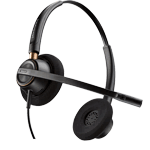Choosing the Right Telephone Headset
As little as 10 years ago, the choices of telephone headsets for your home or office were few, and vendors were limited. Now with the advent of new technology and the internet, the choices are great, and suppliers are plentiful. Choosing the best headset for your application, and finding a company that knows and understands the product with the ability to support your needs before and after the sale has become essential. Choosing the appropriate headset can be accomplished by considering the grade, model, and style of the headset and by selecting an experienced and reputable supplier.
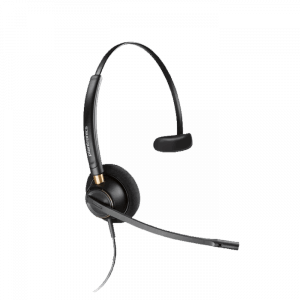
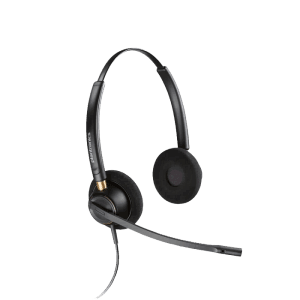
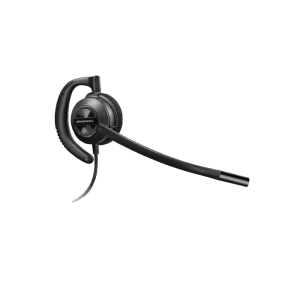
New to telephone headsets? Watch our corded headset basics in the video below to learn what will benefit you.
Consumer vs Professional Grade Headsets:
The potential headset buyer first needs to recognize the difference between two distinct grades of headsets. Local office supply stores stock and sell telephone headsets priced from $50-$75. These are consumer-grade headsets, which are considered entry-level headsets. These headsets supply hands-free communication and provide an excellent solution for 15-20 minute calls while talking to friends and family. The units usually include a single-ear headband or an ear-model headset with an amplifier. The amplifier is required to make the headset compatible with most telephones. Speaker/microphone volume controls are limited, and the headset plugs into a telephone’s handset port. There is typically no compatibility settings on the amplifier, therefore the system may or may not function properly, depending on the telephone it is connected to. The quality is typically equal to or below that of your telephone handset. Comfort will also be sacrificed as manufacturers are forced to cut corners while reducing costs.
For the professional, commercial-grade headsets offer many upgrades with additional choices in a price range from $85-$150, including an amplifier or bottom cable. The quality is much improved over a telephone handset, and the durability will provide for 24-hours-a-day, 7 days-a-week use and abuse for years to come. There are generally 10-15 bottom cables or amplifier to choose from, which guarantee compatibility and ease of use with individual phone systems. In addition, a quick-disconnect connection built into the cord allows the user to disconnect and walk away from the telephone without removing the headset. With professional models, the sound quality will be significantly better, allowing you to hear your caller easily without the need for information to be repeated. With noise-canceling models, your caller will hear your voice above any background noise or other conversations which would normally be very distracting. When choosing the right headset, one of the more popular models is the Plantronics HW510 headset, which fits over your head with a speaker on one ear. It’s lightweight and comfortable for all-day use with a soft foam cushion against your ear.
How Your Environment Dictates What Headset You Use:
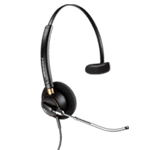 When choosing a particular model of headset, the first thing to consider is the environment in which it will be used. Most commercial-grade headsets are available in two models. Voice-tube models are well used in standard-to-quiet environments, such as private offices or areas with less than 10 employees. Noise-canceling models work well in medium-to-loud environments with 10 or more employees in a common area. The noise-canceling microphone dampens background noise, allowing the user’s voice to be clearer to the other party. Noise-canceling models typically cost $10-$20 more, but in loud environments, they are a worthwhile investment. When choosing the right headset, the Plantronics HW510V headset is an excellent choice for a quieter environment. The voice tube is low profile and will transmit your voice crisply and clearly to your caller. The headset is lightweight for all-day wearing comfort. When paired with a compatible bottom cable or amplifier, you will have a great headset solution for years to come.
When choosing a particular model of headset, the first thing to consider is the environment in which it will be used. Most commercial-grade headsets are available in two models. Voice-tube models are well used in standard-to-quiet environments, such as private offices or areas with less than 10 employees. Noise-canceling models work well in medium-to-loud environments with 10 or more employees in a common area. The noise-canceling microphone dampens background noise, allowing the user’s voice to be clearer to the other party. Noise-canceling models typically cost $10-$20 more, but in loud environments, they are a worthwhile investment. When choosing the right headset, the Plantronics HW510V headset is an excellent choice for a quieter environment. The voice tube is low profile and will transmit your voice crisply and clearly to your caller. The headset is lightweight for all-day wearing comfort. When paired with a compatible bottom cable or amplifier, you will have a great headset solution for years to come.
Headset Wearing Styles:
The next consideration in choosing a headset is the wearing style. Telephone headsets come in two styles: over the head or over the ear. The traditional and most popular headsets are monaural and consist of a headband over the head with a speaker on one ear. Headband models provide a snug fit, with an ear cushion resting gently against the ear. They provide excellent sound transmission and quality along with a comfortable fit. For those who want a lower-profile headset that doesn’t interfere with various hair styles, an over-the-ear model is a good choice. Lightweight and hardly noticeable, an ear model rests gently on and against your ear. An ear model, however, can be awkward to fit with eyeglasses and can feel less stable.
For use in an extremely loud environment, or for those desiring uninterrupted focus when on a call, binaural headsets are the optimal choice. These headsets are styled as headband over the head with speakers covering both ears to block out background noise and other distractions. When choosing a headset for loud environments, the Plantronics HW520 will block out noise around you, allowing you to hear your caller without distractions. You can also upgrade to circumaural ear cushions, which snap onto the speaker and encompass your entire ear. Circumaural ear cushions use a soft leather ear cushion that creates a seal to eliminate most of your background noise while still being comfortable for extended wearing.
Relatively new in the industry are convertible headsets. First-time headset users may want to consider these because they provide multiple wearing styles, which allow the user to find the most comfortable fit. They typically include a headband for over-the-head use, as well as an ear piece for over-the-ear usage.
How To Choose The Best Vendor To Meet Your Needs:
The last decision involved in the purchase of a headset is choosing a vendor. If a reputable and experienced vendor is found, the product knowledge, after sale support and full manufacturer warranty they provide, will be invaluable. Finding a reputable vendor to supply headsets is easy when you know what to look for. First, only consider vendors that are authorized headset suppliers. Speak with their agents and take note of their ability, or lack thereof, to direct their attention to your specific needs. In addition, ask questions about the warranties supplied, return policies, length of time in business, and their relationship with the manufacturer. Beware, many on-line and auction-based companies sell headsets “as is” with no warranties or returns, and many times they ship incorrect items or products with missing parts. Simply put, most of those deals are too good to be true for a reason.
Doing some initial research and choosing the right headset vendor will result in a pleasant experience that will provide numerous benefits to the user. In addition to comfort and convenience, studies have shown that efficiency can increase as much as 43% with the use of a headset, and that neck and shoulder pain can be reduced up to 41%.
About the author: Wayne Baumgartner is the President of Headsets Direct, Inc., an authorized Plantronics distributor. Mr. Baumgartner is the founder of Headsets Direct, which was started in 1996. Further information on telephone headsets may be obtained at www.headsetsdirect.com or by calling Headsets Direct at 1-800-914-7996.
Concepts to consider if you’re looking at purchasing a corded headset. There’s three major factors, first is if a corded headset is your best option, second is wearing style based on personal preference , and third is your environment and how that influences your decision. To start off, there are many manufacturers. We have Plantronics, Jabra GN Netcom, Sennheiser, VXI, and others. It’s beneficial not to talk about specific models or manufacturers, but to cover the concepts of what to look for, how it fits and what’s important to decide on to help make the right buying decision.
So first off; is corded the best option. The reason this comes up first is that corded will be less expensive, but it limits you to roughly 10 to 15 feet of distance. 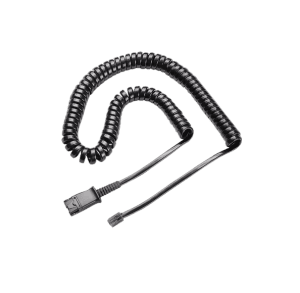 Make sure to put thought into corded versus wireless and your budget. You don’t want to get a corded headset that you find yourself constantly needing a little bit more reach. A typical headset will have a cord that goes down to a quick disconnect. This is anywhere from 15 to 20 inches long. Then every headset always has to plug into an amplifier or bottom cable. Here is a bottom cable, for example, that’s coiled. This is what goes between your headset and your telephone. It’s very important to understand that you’ve got to talk to someone about compatibility. Every headset will work on every phone, but you need a bottom cable that’s compatible. There are many different cables that are wired differently. There’s volume built into some, not others. So it’s critical you get the right cable that ties your headset into your telephone. (Headset Compatibility Guide)
Make sure to put thought into corded versus wireless and your budget. You don’t want to get a corded headset that you find yourself constantly needing a little bit more reach. A typical headset will have a cord that goes down to a quick disconnect. This is anywhere from 15 to 20 inches long. Then every headset always has to plug into an amplifier or bottom cable. Here is a bottom cable, for example, that’s coiled. This is what goes between your headset and your telephone. It’s very important to understand that you’ve got to talk to someone about compatibility. Every headset will work on every phone, but you need a bottom cable that’s compatible. There are many different cables that are wired differently. There’s volume built into some, not others. So it’s critical you get the right cable that ties your headset into your telephone. (Headset Compatibility Guide)
This cable will stretch to give you about 10 feet of range or distance. With that and the headset cable, it gives you the ability to roll back in your chair or stand up, giving you about 10 to 15 feet of mobility from your phone. That works well with some applications if you spend all day at your desk. If you need a little bit more range than that, or you want the mobility of wireless, that’s where wireless really comes into play to give you more distance. Keep that in mind and make sure you’re not limiting yourself with corded and that you’re really good staying within that range of 15 feet.
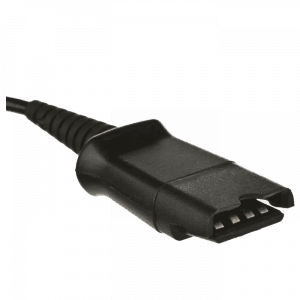 All business grade headsets will have a quick disconnect between the bottom cable or amplifier and the headset itself. If you need to walk away and grab a file, that’s down the hallway, you can pull apart at that quick disconnect and it’s made to do that over and over. You’ll never damage it. When you do that, it puts the person on hold through the headset. You go grab your file. You come back, snap back together and away you go.
All business grade headsets will have a quick disconnect between the bottom cable or amplifier and the headset itself. If you need to walk away and grab a file, that’s down the hallway, you can pull apart at that quick disconnect and it’s made to do that over and over. You’ll never damage it. When you do that, it puts the person on hold through the headset. You go grab your file. You come back, snap back together and away you go.
The first thing to consider is corded really the best option, or do you want to spend a little bit more money and go wireless for more freedom capabilities. Second is wearing style. That really comes down to your personal preference. With the over-the-ear models, what you’re looking at considering is a headset that’s lighter weight and the important thing is nothing over your head. If you are worried about messing your hair up, or you talk to customers face to face and you don’t want something to be distracting, an over-the-ear model works really well.
Ear models are lightweight, comfortable, good sound quality and work in quieter office environments. The louder it gets, the more difficult it becomes to hear, because it just doesn’t seal off enough sound. Some ear loops are bendable and flexible, helping you get a good secure fit. Others will have a cushion against your ear or use ear tips that go in your ear. It comes down to what you’re most comfortable with, but finding one that’s a good fit for all day wearing is what you’re looking for.
The key factors are over-the-ear headsets won’t mess up your hair and it’s a little bit lighter weight. When you go over-the-head, you get a little a larger speaker allowing the cushion to be bigger. That gives a larger seal to separate noise around you, versus what you’re trying to hear. And a bigger speaker means you simply get better sound quality. Headband models work better in average to loud environments. When you look at headband models, you’ll see they have a headband that goes over your head which is adjustable, and a temple pad on the opposite side for stability. That’s what gives you that good secure fit on your head. Once in position, it really stays in place.
The third option to consider is a dual ear headset. When you cover up both ears, what you’re doing is making it where you, the user, can really hear better. It balances the sounds with everything you have coming in on both ears. It allows you to really focus on your callers better because you’re not distracted with anything around you. The more people you have in an environment, the better this works. It’s an amazing concept that happens. If you switch everybody from single ear to dual ear in a loud environment, the noise level of the entire office will drop drastically because everyone’s not trying to talk over each other. The only negative to going this route is if you need to talk to coworkers, you have to temporarily position it behind your ear. Not a big deal, but just factor that in of what’s really the best wearing style; over-the-ear, over-the-head single ear, or over-the-head dual ear.
The last concept to factor in is your environment. Your environment plays a big roll in deciding what headset really works well. Remember, over-the-ear works in the quieter environment. If you’re in a loud call center, and it’s already hard to hear, ear models simply don’t work well because you can’t hear your callers. It defeats the purpose of using a headset.
Voice tube models are made for a quieter environment. They’ll always give you your most crisp, clear voice going to your caller. But, they have to be used in the quieter environment because they don’t have any noise canceling capabilities. Noise canceling picks up your voice and it understands background noise. It then dampens the background noise when audio is transmitted.
In a louder environment, a noise cancelling mic will target your voice better, making it where your caller hears you above any background noise. The environment really comes into play; you want something comfortable from a personal preference point of view, but factor in your environment as you don’t want to purchase a headset that limits your capabilities to where you struggle and can’t hear very well or your caller doesn’t hear because of the background noise around you.
In summary, there are three key factor to consider when selecting a headset. If corded or wireless will be more beneficial versus the cost. What wearing style you would like and what works best in your environment. The benefit of a headset is so you can be hands-free for writing and typing, for a productivity boost. You should avoid trying to kink your neck and cradle the handset up against your neck and shoulder, which causes chronic pain and discomfort over time. You want to be able to write and type freely, be heard really well, and for your callers to hear you. The key is finding a headset that transmits great audio while comfortable for all-day wearing.

